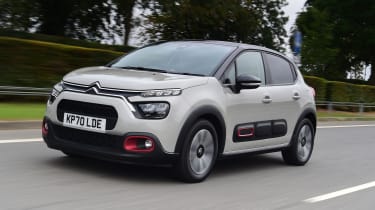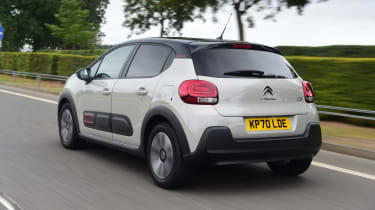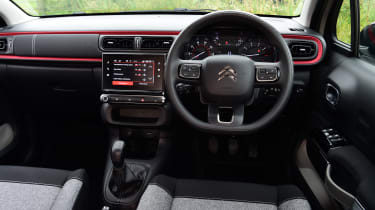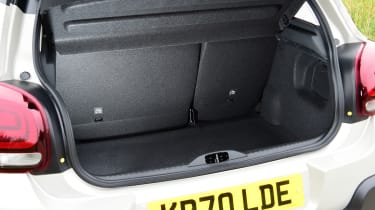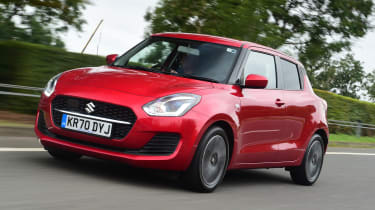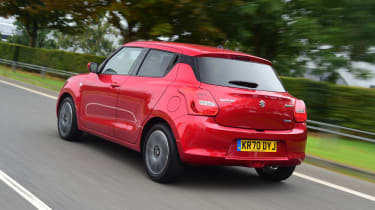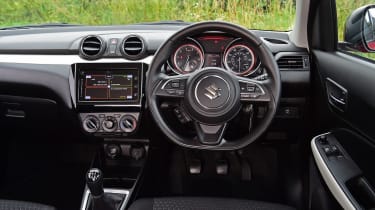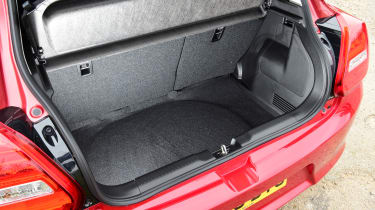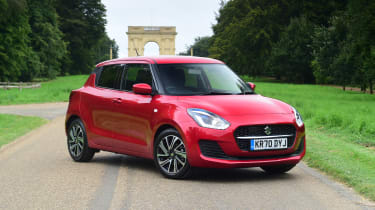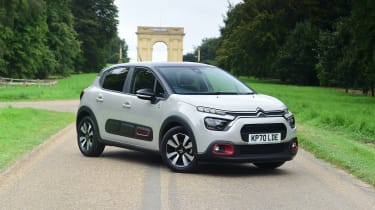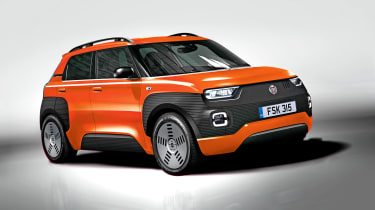The Citroen C3 and Suzuki Swift aim to prove cheap can also be cheerful, but which is the better supermini?
Scour the new-car price lists of Auto Express from 2000, and you’ll see that 30 brands sold cars in the UK for less than £14,000. Now, that number is down to 10.
A big part of that, of course, is down to inflation; back then, 14 grand would’ve got you a decent mid-range Ford Focus. But it’s also a symptom of market pressures. More than ever, it’s harder for brands to squeeze a profit out of small cars. As a result, the choice is much more limited. But while the quantity of cheap cars has decreased, the quality certainly hasn’t. We’ve picked out two superminis that prove a 14-grand budget needn’t mean you miss out on the cheer.
Best superminis 2021
The Citroen C3 cuts a properly unique figure in the small-car segment, choosing to go its own way in terms of both design and engineering. The recently released C-Series trim offers more tempting value than ever before, with added kit relative to other C3 variants, meaning that the French model comes in a shade over £14,000 on the road.
Its rival here is from one of the mainstays of the value-for-money segment. The Suzuki Swift has long aimed for the pragmatic end of the class, and – following generous manufacturer discounts from the Japanese brand – wades in at less than £14,000. So where should you place your hard-earned cash? Read on for our verdict.
Citroen C3
| Citroen C3 PureTech 83 C-Series | |
| Price: | £14,180 |
| Engine: | 1.2-litre 3cyl, 82bhp |
| 0-62mph: | 12.5 seconds |
| Test economy: | 51.3mpg/11.3mpl |
| CO2: | 124g/km |
| Annual road tax: | £155 |
Citroen added the C-Series trim to the C3 line-up – as well as the C3 Aircross and C5 Aircross SUVs – to group the most popular options together into a better-value package. It’s the cheapest C3 model, and is priced from £14,180. Metallic paint (up to £575) and a spare wheel (dealer-fit option) are the only extras, otherwise that’s the price you’ll pay.
More reviews
Car group tests
- Hyundai i20 vs Citroen C3 vs Nissan Micra
- Nissan Micra vs Volkswagen Polo vs Citroen C3
- Citroen C3 vs Hyundai i20 vs Volkswagen Polo
In-depth reviews
- Citroen C3 review
Long-term tests
- Long-term test review: Citroen C3
Road tests
- New Citroen C3 2021 review
- New Citroen C3 BlueHDi diesel 2017 review
Used car tests
- Used Citroen C3 review
Design & engineering
Beside the other superminis in the Stellantis group, the C3’s price looks very cheap. There is one key reason for this: under the skin, the Peugeot 208 and Vauxhall Corsa use the group’s latest CMP platform, while the Citroen uses previous-generation technology.
But while some of the infotainment and safety systems are no longer at the cutting edge, Citroen has focused elsewhere on making the C3 as practical and as interesting as anything else in the class. First, there are the “air bumps” on the outside; this plastic cladding is designed to protect the car against low- speed scrapes and wayward supermarket trolleys. Picked out by the red highlights on this C-Series trim, they’ve become a quirky design feature.
While they provide some cushioning on the outside, more important are what the brand calls its “Advanced Comfort” seats. By applying varying grades of foam within wide, soft chairs, Citroen claims the seats can make every drive as relaxing as possible. There’s plenty of adjustment for a driving position that is just a little higher than the class average.
The seats are placed within a cabin that goes some way to perpetuating the easy-going feel. The uncluttered appearance and clever use of materials mean that even though it’s among the cheapest superminis money can buy, it doesn’t feel nasty. There are still plenty of hard plastics – especially in the back – but that’s not unusual at this level.
Buyers have petrol and diesel engine options. The 1.2-litre petrol is available with a turbo, but we’re driving a C3 without one, and it sends its 82bhp through a five-speed gearbox to the front wheels.
Driving
On the road, it’s immediately clear that the C3 is set up for comfort rather than fun. That’s not in any way a criticism; it only adds another reason to choose the Citroen over firmer rivals like the Swift, and indeed most other superminis. Combined with those squidgy seats, occupants feel far more relaxed in the C3 than they would in most similarly sized cars.
But the suspension tune is by no means perfect; soft damping means that it never settles as quickly as the Swift over larger compressions such as speed bumps, while there is plenty of body roll through corners. There are alternative models which can better isolate the noise of bumps and knocks from the cabin, too, although compared with the Suzuki, the Citroen just holds an edge on refinement.
Yet the 1.2-litre petrol engine is a sweet unit. With three cylinders to the Swift’s four, a little more vibration can be felt through the pedals, but otherwise it’s smooth and quiet. Officially, it’ll cover the 0-62mph dash in 12.5 seconds – 0.6 seconds quicker than the Swift. More relevant than those numbers is that it feels keener than the Suzuki’s unit at low revs, too, so you don’t need to shift down quite as frequently. That’s a good thing, because the C3’s rubbery gearshift feel is rather poor. Coupled with light and vague steering, it robs the driver of any enjoyment that could have otherwise been had.
Practicality
With both cars being so small, it isn’t fair to demand acres of interior space from them. Overall, both are about average for the supermini class. The Suzuki is slightly more spacious when it comes to knee room, but there’s little more than millimetres in it. The Citroen’s soft, flat rear bench means that, while fitting three people in the back is a squeeze for shoulder room, it’s more comfortable than in the Swift.
With 300 litres, the C3 pips the Swift’s 265-litre boot capacity. The rear seat backs fold down in a 60:40 split, increasing that volume to 992 litres, but the space is rather uneven, making it tricky to load larger items. There’s an adjustable boot floor, but the shallow bumper means that it’s fairly easy to lean over and drop items into the space.
The car’s climate controls are integrated into the touchscreen system, which means they aren’t the easiest to use on the move, while the car’s centre console wasn’t designed with the latest smartphones in mind, either, because the shelf beneath the touchscreen is a bit too small to securely hold most modern devices. The light-coloured door pockets mean that it’s easy to find small items dropped into them, though.
Ownership
Citroen's Achilles’ heel as a brand over the past few years has been its ownership experience, and there’s little to indicate that will change soon. In our Driver Power 2021 satisfaction survey the French firm finished a disappointing 28th out of 29 brands. Suzuki fared much better, scoring a mid-table 14th place.
Running costs
One of the benefits of loading up the C-Series with options and then charging less than any other model in the C3 range is that it holds on to its value very well – not only by the standards of its own range but compared with the Swift, too. After three years or 36,000 miles of driving, it’s worth 48.3 per cent of its original value.
At 46 per cent, the Suzuki doesn’t perform quite as strongly. In monetary terms, the C3 will be worth £6,850 after three years, compared with the Swift, which will be worth £6,205. Of course, you do have to pay slightly more for the C3 in the first place, which cancels out some of this benefit.
Testers’ notes
“A fusebox where the glovebox would normally be robs the C3 of valuable storage. The space that’s left is small as a result, restricting practicality.”
Suzuki Swift
| Suzuki Swift 1.2 Hybrid SZ-L | |
| Price: | £13,499 |
| Engine: | 1.2-litre 4cyl mild hybrid, 82bhp |
| 0-62mph: | 13.1 seconds |
| Test economy: | 56.1mpg/12.3mpl |
| CO2: | 106g/km |
| Annual road tax: | £145 |
List prices for the Swift range actually start at £15,499, but Suzuki currently offers a £2,000 discount across the board, so before options the entry-level SZ-L kicks off from £13,499. Add £485 for metallic paint, and the car on test comes to £13,984.
Design & engineering
The third-generation Swift made its debut in 2017, but minor styling revisions have been introduced since; a tweaked grille and new wheel designs were among the changes. This also tied in with the fitment of mild- hybrid technology throughout the Swift line-up. Energy that’s recuperated under braking is stored in a small battery that sits under the passenger seat; this energy is then deployed under acceleration to take a little strain away from the engine and improve fuel economy as a result.
The engine in question is a 1.2-litre petrol unit. While the capacity is nearly identical to the Citroen’s and the pair both make 82bhp, Suzuki achieves this with one extra cylinder. With 107Nm of torque, the Swift’s motor is down 11Nm compared with the C3’s, and peak power is produced 250rpm higher, at 6,000rpm. Front-wheel drive is the only option at the bottom of the Swift range, but the top-spec SZ5 is also available with four-wheel drive.
Step inside, and the Suzuki feels very basic. The quality of the plastics is cheap, with little more than soft pads on the door armrests to break up the hard, scratchy coverings across the entire cabin. The Citroen isn’t the poshest of superminis, but it feels a step up from the Swift. The Suzuki’s driving position is set reasonably high, but only the top-spec SZ5 gets a steering wheel that’s adjustable for reach.
Driving
If you’re the type of driver who doesn’t see why a small price tag is an excuse to sacrifice fun, then the Swift really deserves a look. Compared with the soft and sedate C3, the Suzuki feels sharp, agile and genuinely enjoyable to drive along a twisty road. It’s helped by the fact that, at 911kg, the kerbweight is very light by the standards of the class (it’s 69kg lighter than the Citroen, which is hardly lardy itself), but the suspension is also quite well judged; it’s firm enough to feel sporty, but not harsh or jarring.
The flipside of this is that it isn’t as comfortable as the C3 when it settles down, and when cruising there’s more road noise, especially from the rear.
Yet the steering weights up nicely through the corners, the five-speed manual gearbox is slick, and the engine – although not as muscular as the C3’s motor, despite the hybrid’s torque boost – is still enthusiastic. Officially, the Swift takes 0.6 seconds longer than the C3 to accelerate from 0-62mph; 13.1 seconds in total. Our test Suzuki did tend to kangaroo somewhat on light throttle loads at low revs, as you’d subject it to when crawling in traffic.
Practicality
The Suzuki Swift is both 151mm shorter than the C3 and 94mm narrower. In one way, that boosts its usability in town, because it means that the Japanese model can slip into smaller parking spaces and is easier to fit through width restrictions that are so common in built-up areas. Manoeuvrability is further boosted by a tiny 9.6-metre turning circle, which is more than one metre tighter than the Citroen manages.
On the other hand, its size means that the Suzuki loses out in other areas; thanks to the narrower cabin it feels a little tight, while the boot volume is also smaller than the Citroen’s. The sides of the load bay are finished with plastic, which is more likely to scuff than the rough carpet that lines the C3’s boot. While on paper the Swift’s seats-down volume of 562 litres appears much smaller than the C3’s, that figure is measured to the window line rather than the roof; in reality there isn’t much between them. On the other hand, the Suzuki’s seats fold flatter than the Citroen’s, so even though there’s a bit of a step between the boot floor and the seat backs, it’s a more level space in which to load items.
Storage up front in the Swift is reasonable, with a spacious smartphone cubby and deep door bins; the ones in the back doors are shaped to hold drinks bottles. The Suzuki’s glovebox size is modest, but still better than its competitor’s here.
Ownership
The Swift is one victim of Euro NCAP’s ever-increasing reliance on active collision-avoidance tech. While its adult and child occupant scores were reasonable when it was tested back in 2017, a score of just 25 per cent in the Safety Assist category pegs its overall rating to three stars. One such system it lacks is blind-spot monitoring – not available on the base SZ-L trim, but standard on all other versions. The C3 achieved four stars when NCAP assessed it in 2018.
The Swift comes with a three-year/60,000-mile warranty. Citroen offers five years of cover with the C3, but only if you place your order for the car online. Otherwise, the C3’s warranty terms are largely similar to the Swift’s.
Running costs
Both of these cars are shining examples of how a small, light car with a simple engine can return great fuel economy figures.
In our hands the Suzuki Swift achieved an impressive 56.1mpg, just short of its WLTP-certified 59.7mpg figure. It didn’t vary much according to road conditions, either, with fuel economy similar whether in town or on motorways. A driver covering 12,000 miles a year can expect to pay £1,330 at the pumps. At 51.3mpg, the Citroen is slightly thirstier, with 12,000 miles of fuel coming to £1,455.
The first three annual services for the Swift total £607, which is £74 less than maintaining the Citroen over the same period.
Testers’ notes
“The range-topping Swift Sport has long offered a cheap way into hot hatch ownership, but hybrid tech has blunted performance and bumped up the price.”
Verdict
First place: Suzuki Swift
This pair offer similar stats on paper, but they take very different approaches. The Suzuki Swift is more fun to drive than the C3, and indeed plenty of other supermini alternatives, and it’s also more frugal than the already fuel-sipping Citroen. In the end, though, the Suzuki wins thanks to the tempting monthly payments made possible by the current heavy discounts to the retail price.
Second place: Citroen C3
These two are among the cheapest superminis around, but both have genuine and unique appeal. In the case of the Citroen, that’s comfort; few other small cars feel quite so cosseting. It feels like a higher-quality product than the Suzuki and performance is marginally stronger, but in a sector where affordability is key, the pricier C3 must come second.
Coming soon…
Fiat Panda
Model: Fiat Panda EVDue: 2022Price: £19,000 (est) Power: e-motor, 90bhp (est)
Affordable electric vehicles are hard to come by, but the next Panda will be a step in the right direction. Fiat bosses want it to undercut the new 500, so a sub-£20,000 price tag is likely.
Figures
| Suzuki Swift 1.2 Hybrid SZ-L | Citroen C3 PureTech 83 C-Series | |
| On the road price/total as tested | £13,499/£13,984 | £14,180/£14,180 |
| Residual value (after 3yrs/36,000) | £6,205/46.0% | £6,850/48.3% |
| Depreciation | £7,294 | £7,330 |
| Annual tax liability std/higher rate | £768/£1,536 | £809/£1,617 |
| Annual fuel cost (12k/20k miles) | £1,330/£2,217 | £1,455/£2,425 |
| Insurance group/quote/VED | 20/£434/£145 | 14/£449/£155 |
| Cost of 1st/2nd/3rd service | £129/£279/£199 | £681 (3 years) |
| Length/wheelbase | 3,845/2,450mm | 3,996/2,539mm |
| Height/width | 1,495/1,735mm | 1,474/1,829mm |
| Engine | 4cyl in-line/1,197cc | 3cyl in-line/1,199cc |
| Peak power/revs | 82/6,000 bhp/rpm | 82/5,750 bhp/rpm |
| Peak torque/revs | 107/2,800 Nm/rpm | 118/2,750 Nm/rpm |
| Transmission | 5-spd manual/fwd | 5-spd manual/fwd |
| Fuel tank capacity/spare wheel | 37 litres/optional | 45 litres/optional |
| Boot capacity (seats up/down) | 265/579* litres | 300/992** litres |
| Kerbweight/payload/towing weight | 911/454/1,000kg | 980/560/450kg |
| Turning circle | 9.6 metres | 10.9 metres |
| Basic warranty (miles)/recovery | 3 yrs (60,000)/1 yr | 3 yrs (60k)/1 yr (£120) |
| Driver Power manufacturer position | 14th | 28th |
| NCAP: Adult/child/ped./assist/stars | 83/75/69/25/3 (2017) | 88/83/59/58/4 (2018) |
| 0-62mph/top speed | 13.1 secs/112mph | 12.5 secs/105mph |
| Auto Express econ. (mpg/mpl)/range | 56.1/12.3/457 miles | 51.3/11.3/508 miles |
| WLTP combined | 59.7mpg | 48.5-54.3mpg |
| WLTP combined | 12.3mpl | 11.3mpl |
| Actual/claimed CO2/tax bracket | 116/106g/km/26% | 127/124g/km/29% |
| Airbags/Isofix | Six/yes | Six/yes |
| Parking sensors/camera | No/yes | Yes/no |
| Auto box/lane-keep/blindspot/AEB | No/no/no/yes | No/yes/no/yes |
| Climate control/cruise control | AC/adaptive | Yes/yes |
| Leather/heated seats | No/no | No/no |
| Metallic paint/LED headlights | £485/yes | £575/yes |
| Keyless entry & go/powered tailgate | No/no | No/no |
| Sat-nav/digital dashboard | No/no | £400/no |
| DAB/connected services | Yes/no | Yes/no |
| Wireless charging | No | No |
| Apple CarPlay/Android Auto | No/no | Yes/yes |
Next Steps
Source: Read Full Article


 Best superminis 2021
Best superminis 2021